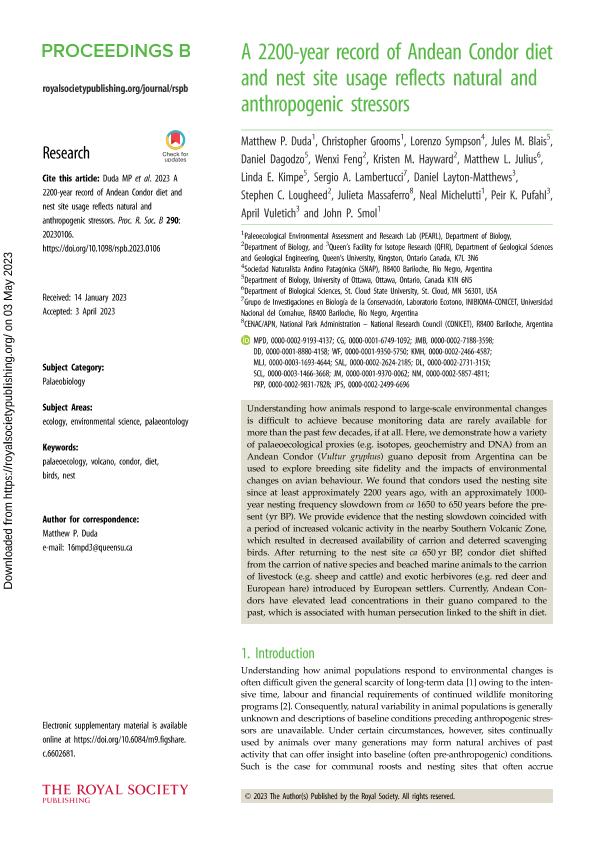Mostrar el registro sencillo del ítem
dc.contributor.author
Duda, Matthew P.
dc.contributor.author
Grooms, Christopher
dc.contributor.author
Sympson, Lorenzo
dc.contributor.author
Blais, Jules M.
dc.contributor.author
Dagodzo, Daniel
dc.contributor.author
Feng, Wenxi
dc.contributor.author
Hayward, Kristen M.
dc.contributor.author
Julius, Matthew L.
dc.contributor.author
Kimpe, Linda E.
dc.contributor.author
Lambertucci, Sergio Agustin

dc.contributor.author
Layton Matthews, Daniel
dc.contributor.author
Lougheed, Stephen

dc.contributor.author
Massaferro, Julieta

dc.contributor.author
Michelutti, Neal
dc.contributor.author
Pufahl, Peir K.
dc.contributor.author
Vuletich, April
dc.contributor.author
Smol, John P.
dc.date.available
2023-12-01T13:59:41Z
dc.date.issued
2023-05
dc.identifier.citation
Duda, Matthew P.; Grooms, Christopher; Sympson, Lorenzo; Blais, Jules M.; Dagodzo, Daniel; et al.; A 2200-year record of Andean Condor diet and nest site usage reflects natural and anthropogenic stressors; The Royal Society; Proceedings of the Royal Society of London. Series B: Biological Sciences; 290; 1998; 5-2023; 1-11
dc.identifier.issn
0962-8452
dc.identifier.uri
http://hdl.handle.net/11336/218979
dc.description.abstract
Understanding how animals respond to large-scale environmental changes is difficult to achieve because monitoring data are rarely available for more than the past few decades, if at all. Here, we demonstrate how a variety of palaeoecological proxies (e.g. isotopes, geochemistry and DNA) from an Andean Condor (Vultur gryphus) guano deposit from Argentina can be used to explore breeding site fidelity and the impacts of environmental changes on avian behaviour. We found that condors used the nesting site since at least approximately 2200 years ago, with an approximately 1000-year nesting frequency slowdown from ca 1650 to 650 years before the present (yr BP). We provide evidence that the nesting slowdown coincided with a period of increased volcanic activity in the nearby Southern Volcanic Zone, which resulted in decreased availability of carrion and deterred scavenging birds. After returning to the nest site ca 650 yr BP, condor diet shifted from the carrion of native species and beached marine animals to the carrion of livestock (e.g. sheep and cattle) and exotic herbivores (e.g. red deer and European hare) introduced by European settlers. Currently, Andean Condors have elevated lead concentrations in their guano compared to the past, which is associated with human persecution linked to the shift in diet.
dc.format
application/pdf
dc.language.iso
eng
dc.publisher
The Royal Society

dc.rights
info:eu-repo/semantics/openAccess
dc.rights.uri
https://creativecommons.org/licenses/by-nc-sa/2.5/ar/
dc.subject
BIRDS
dc.subject
CONDOR
dc.subject
DIET
dc.subject
NEST
dc.subject
PALAEOECOLOGY
dc.subject
VOLCANO
dc.subject.classification
Ciencias Medioambientales

dc.subject.classification
Ciencias de la Tierra y relacionadas con el Medio Ambiente

dc.subject.classification
CIENCIAS NATURALES Y EXACTAS

dc.title
A 2200-year record of Andean Condor diet and nest site usage reflects natural and anthropogenic stressors
dc.type
info:eu-repo/semantics/article
dc.type
info:ar-repo/semantics/artículo
dc.type
info:eu-repo/semantics/publishedVersion
dc.date.updated
2023-11-28T15:04:50Z
dc.journal.volume
290
dc.journal.number
1998
dc.journal.pagination
1-11
dc.journal.pais
Reino Unido

dc.journal.ciudad
Londres
dc.description.fil
Fil: Duda, Matthew P.. Queen's University; Canadá
dc.description.fil
Fil: Grooms, Christopher. Queen's University; Canadá
dc.description.fil
Fil: Sympson, Lorenzo. Sociedad Naturalista Andino Patagonica; Argentina
dc.description.fil
Fil: Blais, Jules M.. University of Ottawa; Canadá
dc.description.fil
Fil: Dagodzo, Daniel. University of Ottawa; Canadá
dc.description.fil
Fil: Feng, Wenxi. Queen's University; Canadá
dc.description.fil
Fil: Hayward, Kristen M.. Queen's University; Canadá
dc.description.fil
Fil: Julius, Matthew L.. St. Cloud State University; Estados Unidos
dc.description.fil
Fil: Kimpe, Linda E.. University of Ottawa; Canadá
dc.description.fil
Fil: Lambertucci, Sergio Agustin. Consejo Nacional de Investigaciones Científicas y Técnicas. Centro Científico Tecnológico Conicet - Patagonia Norte. Instituto de Investigaciones en Biodiversidad y Medioambiente. Universidad Nacional del Comahue. Centro Regional Universidad Bariloche. Instituto de Investigaciones en Biodiversidad y Medioambiente; Argentina
dc.description.fil
Fil: Layton Matthews, Daniel. Queen's University; Canadá
dc.description.fil
Fil: Lougheed, Stephen. Queen's University; Canadá
dc.description.fil
Fil: Massaferro, Julieta. Consejo Nacional de Investigaciones Científicas y Técnicas. Centro Científico Tecnológico Conicet - Patagonia Norte. Instituto de Investigaciones en Biodiversidad y Medioambiente. Universidad Nacional del Comahue. Centro Regional Universidad Bariloche. Instituto de Investigaciones en Biodiversidad y Medioambiente; Argentina
dc.description.fil
Fil: Michelutti, Neal. Queen's University; Canadá
dc.description.fil
Fil: Pufahl, Peir K.. Queen's University; Canadá
dc.description.fil
Fil: Vuletich, April. Queen's University; Canadá
dc.description.fil
Fil: Smol, John P.. Queen's University; Canadá
dc.journal.title
Proceedings of the Royal Society of London. Series B: Biological Sciences

dc.relation.alternativeid
info:eu-repo/semantics/altIdentifier/url/https://royalsocietypublishing.org/doi/10.1098/rspb.2023.0106
dc.relation.alternativeid
info:eu-repo/semantics/altIdentifier/doi/http://dx.doi.org/10.1098/rspb.2023.0106
Archivos asociados
